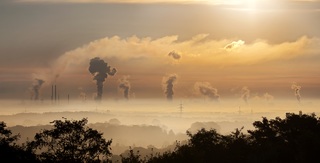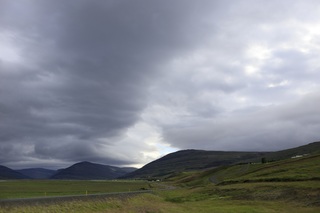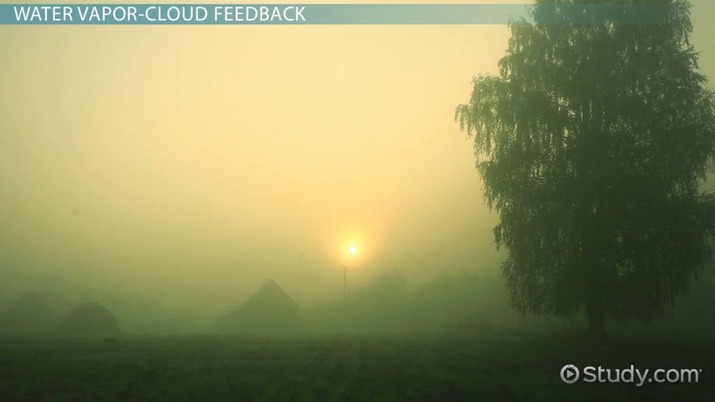Climate Change Feedback Mechanisms | Definition & Types
Table of Contents
- What is a Feedback Mechanism?
- Climate Feedback Loops
- Positive Feedback Loop
- Negative Feedback Loop
- Lesson Summary
What is the ice-albedo feedback loop?
The ice-albedo feedback loop is a positive feedback mechanism in climate change. The term albedo represents how much sunlight is reflected away from earth. Being a white surface, icebergs and ice sheets have a high albedo and help keep radiant energy from hitting the earth's surface and warming it. But as the temperature of air and ocean water warms, such as due to higher levels of greenhouse gases that trap heat near the earth's surface, the ice melts. Less ice mean less redirection of radiant energy into the atmosphere. That leads to more heat absorbed in the ocean and more ice melting.
What is a greenhouse gas?
Examples of greenhouse gases are carbon dioxide, nitrous oxide, methane, and water vapor. Naturally, the earth's surface absorbs some of the sun's radiant energy and redirects the rest to outer space. The above gases, however, trap the sun's radiant energy so that less heat is returned to space, making it warm enough on Earth's surface to support biological life. However, as each of these gases accumulate in the earth's lower atmosphere, they change the planet's radiative energy balance. The increasing accumulation of certain greenhouse gases in the atmosphere due to human activity leads to further solar radiation being trapped in the atmosphere, making Earth increasingly hotter.
What is a feedback loop in climate example?
Atmosphere-biota interactions are an example of a negative feedback mechanism in climate change. Biota means plant and animal life, and forest growth is the best example of the atmosphere-biota interaction. As trees grow, they absorb carbon dioxide to under go photosynthesis, grow, and produce oxygen. Hence trees are a reservoir, or carbon sink, for carbon dioxide and help lower the temperature of Earth's surface. Additionally, trees transpire during growth, releasing water vapor into the atmosphere. That water vapor spurs the development of clouds. Clouds help reflect radiant energy back into space, thereby cooling the earth's surface.
Table of Contents
- What is a Feedback Mechanism?
- Climate Feedback Loops
- Positive Feedback Loop
- Negative Feedback Loop
- Lesson Summary
Biologists use the term feedback mechanism to explain how physiological processes move towards or away from the state of homeostasis in an organism's body. Homeostasis is the normal, stable state of an organism. For example, a person's normal heart rate may be 70 beats per minute when he or she is calm and relaxed. If frightened into a state of panic, however, that person's heart rate will increase rapidly to 100 beats per minute. Conversely, if that person has blocked arteries due to plaque build up, the individual's heart will beat more slowly, perhaps as low as 55 beats per minute.
The same concept of moving towards or from a state of normality applies to climate feedback mechanisms. However, such mechanisms are only one of three climate change components that scientists investigate. The other two components are forcing and the climate tipping point. Climate forcing is a physical process that instigates climate change. A climate feedback mechanism is a process that either escalates or diminishes the initial warming of Earth's climate. Climate tipping point is the point at which our planet's climate has suddenly shifted from one relatively stable state to another, often irreversibly.
There are many types of climate forcing factors that change the earth's existing climate system, and each factor originates from outside that climate system. The complete climate system for Earth includes all storage basins of water (oceans, lakes, rivers, etc.), all land surfaces and biomes (grasslands, forests, deserts, etc.), all frozen landscapes (arctic tundra, icebergs, glaciers, etc.), and the atmosphere (multiple layers of gases surrounding the planet). Below are a description of three major climate forcing factors.
- Solar radiation -- The sun emits electromagnetic radiation onto the earth's surface. Because Earth is a massive, round planet that orbits the sun on a tilted axis, the amount of radiation that hits the earth's surface varies throughout the year, throughout each day and among geographic regions. For instance, the south and north poles rarely get high emissions of solar radiation yet countries along the equator are regularly positioned closest to the sun's radiative force. Localized weather patterns and landscape structures also influence how much solar radiation hits Earth's surface.
- Emissions of carbon dioxide, nitrous oxide, and methane -- Each type of gas traps heat on the earth's surface, thereby altering the balance between how much heat the earth absorbs from the sun and how much heat it releases into the atmosphere. This alteration of Earth's radiative balance is known as the greenhouse gas effect. Water vapor is another naturally occurring greenhouse gas, and all of them help support biological life by providing the warm temperature that organisms need to grow and survive. However, increasing accumulation of certain greenhouse gases in the atmosphere, often due to human activity, leads to more solar radiation being trapped in the atmosphere, making Earth increasingly hotter.
- Tiny airborne particles originating from aerosols, dust, smoke, and soot (also called black carbon) -- Sulfate aerosols originate from coal burning and volcanic eruptions, and they cool the earth. Black carbon, however, is one type of particle that warms Earth's climate.
 |
Events that could lead to a climate tipping point include the melting of icebergs and ice sheets and the thawing of permafrost (frozen soil on the ground's surface and upper soil layers) in the Arctic. As more water fills the oceans, more heat gets trapped in the oceans because water absorbs heat, whereas ice reflects heat. Moreover, the circulation of water within the Atlantic Ocean would also change, thereby impacting the flow of the Gulf Stream. This, in turn, would alter global weather patterns. If the permafrost thaws, it will allow allow massive volumes of methane and carbon dioxide gas to escape from the ground and enter the atmosphere. Of course, on the opposite end of the spectrum would be persistent cloud cover over much of the earth. Under this long-term scenario, the sun's radiant energy could not hit the earth's surface, causing plants to die and colder temperatures to pervade. Increasingly, more ice and snow would cover the planet. All of these climatic events would make it especially hard for Earth's climate system to return to its original, stable state.
Exploring climate feedback mechanisms more closely, there are four primary environmental conditions that facilitate climate feedback loops.
1. Clouds
Clouds can reflect about a third of the sun's light back into space. So, a warmer climate means more cloud formation because more moisture is held within the atmosphere. Increased cloud cover also means less heat is trapped near the earth's surface, thereby slowing down the warming of Earth's climate.
 |
2. Precipitation
Although a warmer climate allows for more moisture to be held in the atmosphere, not all regions of the world would get increased rain or snow fall. Some regions may actually become drier. This is because the circulation of water within oceans plays a significant role in shaping the weather patterns in each region of the world. Of course, in those areas where precipitation rises, more vegetation may also grow that could remove more carbon dioxide from the atmosphere, in addition to increased flood events.
3. Forest Growth and Ocean Basins
Both forests and oceans absorb carbon dioxide and are known as carbon sinks. Carbon dioxide, however, is released into the atmosphere when forests are burned and logged. This greenhouse gas may even escape oceans as ocean water continually warms, according to new climate studies coming out of Australia.
 |
4. Ice Albedo
It's not only a warming atmosphere that thaws ice but also warmer ocean water. Thus, ice albedo is one feedback loop that has a powerful influence on whether or not Earth could reach its climate tipping point.
There are multiple kinds of climate feedback loops, which are are categorized as either positive or negative. A positive feedback loop increases the amount of climate warming on Earth, and a negative feedback loop decreases that warming effect. The remaining sections describe each category in more detail.
Positive feedback loops destabilize the near-surface air temperature on Earth and exacerbate the effect of global warming, as is currently happening across the planet. The are multiple types of positive feedback mechanisms: (1) ice albedo feedback, (2) atmosphere-ocean interactions, and (3) carbon cycle feedback. During such situations, long-wave radiation from the sun is absorbed on Earth's surface rather than lost to space. For every watt per square meter of radiative forcing that hits the Earth's surface and is absorbed by land or water, the planet's climate increases anywhere between 0.9 and 1.8 degrees Fahrenheit (0.5 to 1.0 degrees Celsius). In sum, during positive feedback mechanisms a slight deviation from the climate's normal state can lead to a major change throughout the climate system.
Ice Albedo Feedback
Ice albedo feedback is a positive climate feedback mechanism. The word "albedo" refers to how much radiant light is reflected off a surface. The higher the albedo, the more reflective the surface is. Ice, being white in color, reflects much more sunlight than dry land and ocean water. Consequently, as Earth's ambient temperature and ocean waters warm, more ice melts in the North and South Poles, across Greenland, and in the arctic tundra. This melting leads to more available ocean water that will absorb sunlight rather than redirecting it back into space. The cycle of more ice melting and more heat being trapped in the ocean perpetuates until something happens to cool the earth, such as significantly less greenhouse gases being emitted into the atmosphere. As the ocean water warms it expands, leading to sea levels rising, which affects coastal communities and ecosystems.
 |
Atmosphere-Ocean Interactions
Another positive climate feedback mechanism is atmosphere-ocean interactions. Oceans are the largest water storage basins on Earth and absorb more solar radiation than do ice and land surfaces, storing that heat within their top 10 feet (3 meters). As ocean water evaporates, it releases water vapor into the atmosphere. Additionally, oceans release aerosols that facilitate cloud formation in the atmosphere. Thus oceans play a significant role in generating precipitation that falls on land. Lastly, oceans absorb carbon dioxide from the atmosphere and store it deep within their basins.
With regard to climate change, water vapor is a form of gas that has much stronger greenhouse effects than carbon dioxide, nitrous oxide, and methane; nor can its atmospheric concentration vary as easily as the other gases. This is because the temperature of Earth's lower atmosphere and surface dictate the concentration of atmospheric water vapor. Scientists have long assumed that as air temperature rises, the air can hold increasingly more water vapor. Thus, as the earth's surface temperature rises, the net greenhouse gas effect of water vapor also increases, which only perpetuates the global warming cycle. This is why climate scientists predict more powerful hurricanes and typhoons, both of which form over warm ocean water, if Earth's global warming process continues unchecked.
Carbon Cycle Feedback
As previously mentioned, the ocean and forests act as a reservoir, or sink, for carbon dioxide. Scientists estimate that oceans can absorb about one-third of the carbon dioxide that humans emit into the atmosphere. Terrestrial plants can absorb about one-quarter of this greenhouse gas. When absorbed within oceans, carbon dioxide facilitates acidification. That is, the dissolved gas creates carbonic acid which reacts with carbonate ions in the water to form bicarbonate. During this process, less carbon ions are available for coral reefs, snails, crabs and other shell-building creatures to create calcium carbonate shells. On the flip side, however, more acidic oceans could dissolve more rocks that leads to an influx of carbonate ions that, in turn, could absorb more carbon dioxide from the atmosphere. Unfortunately, phytoplankton thrive in cool waters that are replete with nutrients. Warmer oceans mean less phytoplankton and, therefore, less atmospheric carbon absorption.
With regards to terrestrial plants, carbon dioxide is a fertilizer for plant growth. As forests are logged and burned for human and agricultural development, however, increasingly more carbon dioxide is released into the atmosphere. Furthermore, increasingly warmer temperatures yields drier soils and drier plants which, in turn, facilitates more insect infestations and more wildfires. Note, even warmer soils can release carbon dioxide, such as in the arctic as permafrost thaws.
As a stabilizing mechanism for climate regulation, negative feedback loops help limit the amount of heat being trapped on or below Earth's aquatic and terrestrial surfaces. Therefore, negative feedback mechanisms like the water vapor-cloud feedback loop and atmosphere-biota interactions, help return Earth's climate system to its original stable state.
Water Vapor-Cloud Feedback
The water vapor-cloud feedback loop mimics the ice albedo feedback but with an opposite outcome. Clouds have a lower albedo than ice yet a higher albedo compared to water and land. This means that when the earth's surface temperature increases, water evaporates from the oceans, spurring the development of low lying clouds. These clouds reflect some of the sun's radiative forcing and help minimally cool the earth's surface.
Atmosphere-Biota Interactions
Biota refers to the plant and animal species found in an area, and atmosphere-biota interactions help return earth's climate system to a more stable state. This is because terrestrial and aquatic plants absorb a lot of the sun's heat to conduct photosynthesis. During photosynthesis, the plants also absorb carbon dioxide to produce oxygen. This is one way in which plants help the earth's climate system return to its original state. Plants also transpire during photosynthesis, meaning they release water vapor into the atmosphere. As discussed earlier, more atmospheric water vapor yields more clouds, and clouds help reflect the sun's radiant energy back into space. Thus, as carbon dioxide sinks and producers of water vapor, plants help cool Earth's climate system.
 |
Feedback mechanisms help regulate an organism's bodily functions so that, hopefully, all organs of the creature return to homeostasis (i.e., normal, original state) after a disruptive event. Climate feedback mechanisms work in a similar way for regulating Earth's climate system. There are positive feedback loops and negative feedback loops, during which the former exacerbate the planet's surface warming event and the latter reverse it. Overall, though, there are three components to climate change that gain the attention of earth scientists: forcing, climate feedback mechanisms, and climate tipping point. Climate forcing is a physical process that instigates a climate change, namely due to solar radiation, greenhouse gases, and tiny airborne particulate matter. Greenhouse gases trap heat near the earth's surface so that less radiant energy returns to space. Climate tipping point is the event that decisively shifts the earth's climate from one stable state to another. Factors that facilitate climate feedback mechanisms, both positive and negative, include the following: (1) clouds, (2) precipitation, (3) forest growth, and (4) ice.
There are tree types of positive feedback loops.
- Ice albedo feedback -- The word "albedo" refers to how much radiant light is reflected off a surface. As the surface air on Earth warms, the ocean water also warms and ice at the North and South Poles melt. As the oceans fill with more warm water, more ice melts.
- Atmosphere-ocean interactions -- As Earth's surface air warms, the ocean water warms and generates more water vapor in the atmosphere. Water vapor is more potent than other greenhouse gases because its atmospheric concentration is difficult to alter.
- Carbon cycle feedback -- Both forests and oceans absorb and store carbon dioxide from the atmosphere, with oceans possibly absorbing as much as 70%. If these repositories have a maximum capacity threshold, however, more carbon dioxide could remain in the atmosphere and exacerbate Earth's current global warming problem.
Negative climate feedback loops counter the destabilizing effects of the above feedback mechanisms by cooling the earth's surface.
- Water vapor-cloud interactions -- As the atmospheric concentration of water vapor increases, more clouds develop in the lower atmosphere and reflect sunlight away from Earth's surface. Although clouds have a lower albedo than ice, they can still help lower Earth's surface temperature.
- Atmosphere-biota interactions -- Biota means animal and plant life in a particular area, but it is plants that depend on carbon dioxide to undergo photosynthesis and produce oxygen for other life forms. Thus, large swaths of increased plant life create carbon sinks that can offset Earth's current global warming problem by absorbing carbon dioxide from the atmosphere. Additionally, as plants transpire during photosynthesis, they release water vapor into the atmosphere, instigating the water vapor-cloud interaction mentioned above.
Video Transcript
Feedback Mechanisms
Just like this rock formation, the earth's climate represents a delicate balancing act. There is a precise equilibrium between the energy coming in from the sun and the energy being reflected back into space from the planet's surface.
When an event occurs, such as humans adding greenhouse gases to the atmosphere, this equilibrium is disturbed. In response, the climate will either warm up or cool down to reset the balance. In this example, greenhouse gases prevent solar radiation from being reflected back into space. However, to keep the balance, energy must be reflected back into space from the planet. So, the climate warms up, allowing more energy to be released as heat, until the original balance has been restored.
The climate responds through what is referred to as feedback mechanisms. A feedback mechanism is a process that allows a system, such as climate, to self-regulate in response to a change, such as increasing greenhouse gases.
A common example of a feedback mechanism is the thermostat in your home. When the temperature inside becomes too cold, the heater switches on, warming up the air. Once the air reaches the correct temperature, the heater switches off, and the air starts to cool back down. This process repeats, allowing you to keep your room at a stable temperature.
The earth's climate has several feedback mechanisms, such as the ice-albedo feedback, the water vapor-cloud feedback, the atmosphere-ocean interactions, and the atmosphere-biota interactions.
Ice-Albedo Feedback
Albedo is derived from the Latin term for 'whiteness' and refers to how reflective a surface is. The more ice there is on the earth's poles, the higher the earth's albedo.
When the earth is very 'white,' it becomes more reflective. You have likely noticed this effect if you have ever been skiing. When the earth has a high albedo, more of the sun's radiation is reflected back into space and less is absorbed by the planet. This has the effect of keeping our planet cooler.
Here is how the ice-albedo feedback loop operates. The amount of radiation that the earth receives from the sun does not always stay the same. When the sun sends more radiation to the earth's surface, the planet starts to heat up. This increase in temperature causes the ice at the poles to melt. Less ice means that the planet's albedo decreases. Less radiation is reflected back into space and more is absorbed, causing the earth to heat up even more. A warmer planet means more ice melting, less radiation reflected back, and more absorbed, and so on. As you can see, the ice-albedo feedback loop causes the planet to continue to heat up.
This is what is referred to as positive feedback. In positive feedback, the initial effect is enhanced or increased. In this case, the initial effect was warming caused by increased solar radiation. The positive feedback loop causes the warming to continually increase.
Water Vapor-Cloud Feedback
Lucky for us, and everything else on our planet, the ice-albedo feedback loop does not continue unchecked. This is where the water vapor-cloud feedback loop, an example of negative feedback, comes into play. In negative feedback, the initial effect is counteracted or decreased. The thermostat we discussed in the introduction is another example of negative feedback.
As you have probably noticed, on a very foggy day, water droplets in the air make it hard to see. This is because they are scattering and reflecting the sun's rays. While this can make it hard to drive your car, it also helps keep the earth cool as the sun's radiation is bounced back into space.
As the planet warms up, the oceans begin to evaporate at a higher rate. This water vapor in the atmosphere leads to the formation of clouds, or water droplets in the sky. The clouds (notice that they are white like the snow) reflect the sun's radiation away from the planet, causing the earth to cool back down. Thus, the water vapor-cloud feedback loop keeps the planet from heating up forever.
Atmosphere-Ocean Interactions
Another example of positive feedback can be found in the earth's atmosphere-ocean interactions.
The ocean serves as a giant storage vault for carbon dioxide, one of the primary greenhouse gases. Nearly half of the carbon dioxide that humans have added to the atmosphere in the last 100 years (through factories, cars, and the burning of fossil fuels) has been absorbed by the oceans.
Here is where the feedback loop comes in. Colder water can hold more carbon dioxide than warmer water. As the atmosphere heats up, so do the oceans. The warming water allows carbon dioxide to escape into the atmosphere, enhancing the greenhouse effect and further warming the planet.
Atmosphere-Biota Interactions
We find an example of negative feedback in Earth's atmosphere-biota interactions. Biota simply refers to all of the living creatures - plant, animal, or otherwise - in a particular area. In this case, we are looking at all of the living creatures on the planet, particularly the plant life. Plants both on land and in the ocean play a very large role in the stability of our climate. They are essential in removing carbon dioxide from the atmosphere during the process of photosynthesis.
Additionally, returning to the concept of albedo, as the temperature around plants increases, they lose more water through transpiration. Transpiration refers to the evaporation of water from plants' leaves. More water in the atmosphere means more cloud cover, which reflects solar radiation back into space.
So, a warmer climate leads to more plant life. Increased plant life means that more carbon dioxide is removed from the atmosphere and more clouds are added. This leads to less greenhouse gases trapping heat and more of the sun's rays being reflected away from the planet. As a result, the climate cools down. You can see that plants are important in combating global warming!
Lesson Summary
So let's review what we have learned. The earth's climate is in a delicate equilibrium between the energy coming in from the sun and the energy being reflected back into space from the planet's surface. Whenever there is a shift in this equilibrium, the climate responds through various feedback mechanisms.
A feedback mechanism is a process that allows a system, such as climate, to self-regulate in response to a change, such as increasing greenhouse gases. Feedback can be either positive or negative. In positive feedback, the initial effect is enhanced or increased. In negative feedback, the initial effect is counteracted or decreased.
Two examples of positive feedback in the climate are the ice-albedo feedback and the atmosphere-ocean interactions. Albedo is derived from the Latin term for 'whiteness' and refers to how reflective a surface is.
Two examples of negative feedback in the climate are the water vapor-cloud feedback and atmosphere-biota interactions. Biota refers to all of the living creatures - plant, animal or otherwise - in a particular area.
Register to view this lesson
Unlock Your Education
Become a Study.com member and start learning now.
Become a MemberAlready a member? Log In
BackResources created by teachers for teachers
I would definitely recommend Study.com to my colleagues. It’s like a teacher waved a magic wand and did the work for me. I feel like it’s a lifeline.






